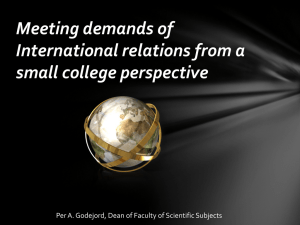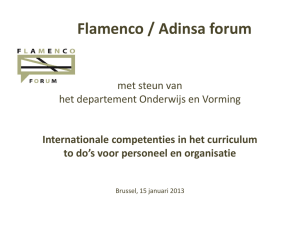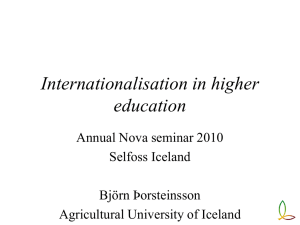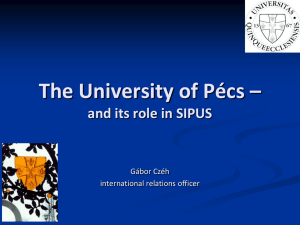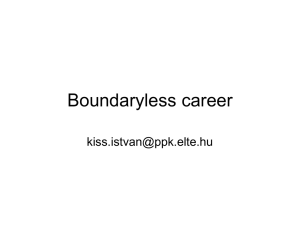here - University of Queensland
advertisement
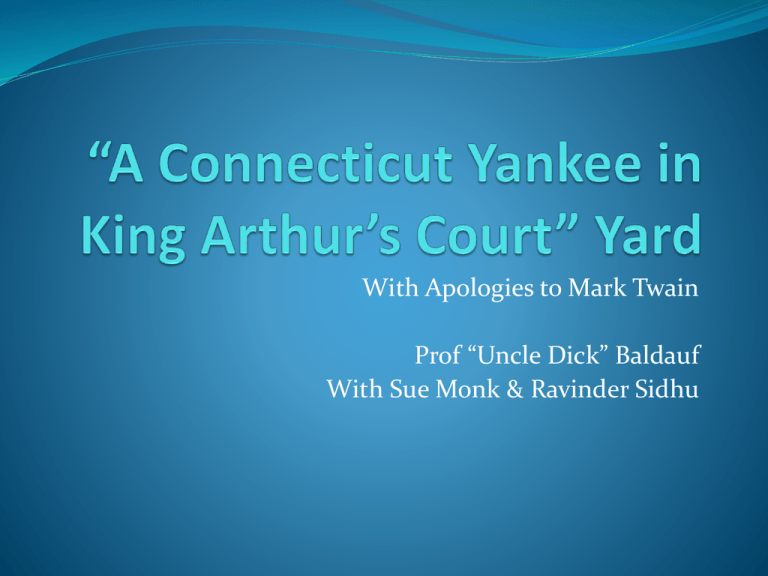
With Apologies to Mark Twain Prof “Uncle Dick” Baldauf With Sue Monk & Ravinder Sidhu Internationalising the Curriculum Internationalisation Large Scale Policy Decisions University level decisions School Level Decisions Course Level Decisions Individual experiences, identity and agency Internationalisation World wide phenomenon in tertiary education (+ Globalisation) Offering programs in English to attract international students and prepare local students for global situations – MOI, EMI, CLIL, CBI, ICLTHE Productive cross-cultural encounters Internationalisation of Graduates Know, that is, to have a critical awareness of local and global perspectives on issues of professional, political, environmental and social significance; 2. Do, that is, be able to communicate effectively with people from other cultural backgrounds other than their own about these issues; 3. Be, that is be responsible global citizens able to engage with issues of equity, social justice and sustainability (Green, 2012) 4. However, this has implications for lecturers too. 1. Large Scale Policy Decisions There are statements made at the national level about the need for internationalisation, e.g.: White Paper, Australia in an Asian Century. “Australians need to build Asia-relevant’ capabilities— both broad-based and specialized” Invests responsibility in schools, universities and vocational institutions to build this capacity. University Level Initiatives Universities have translated these policy statements into local requirements: UQ’s Global Strategy & Internationalisation plan http://www.uq.edu.au/international/docs/global_strat egy_and_internationalisation_at_UQ.pdf Teaching and Learning Enhancement Plan Internationalisation of the curriculum award (2012) School Level Policies / Actions What we did Internationalisation Committee meetings School retreat with invited speakers School ‘audit’ What we found Rich and extensive range of skills & experiences amongst staff and students What we are planning Highlight expertise in the school Workshop series Internationalisation page on SoE website Address issues raised in audit Course Level Opportunity These requirements are expected to be translated into action at the course level. Different courses will have different requirements. Not a case of one-size-fits-all. Co-constructing courses ; international literature Rationales & strategies: Whalley, TR 1997, Best practice guidelines for internationalizing the curriculum, Ministry of Education, Skills and Training, Victoria, British Columbia Individual Experiences, Identity and Agency Lecturers do this in various ways drawing on their: Experiences Identity Agency In this talk, I am going to try to give you some ideas of how I have tried to do this, and to provide some examples about the importance of understanding internationalisation via language and cultural issues. So, what about me? “A Connecticut Yankee in King Arthur’s Court” (Mark Twain, 1889) In a case of internationalisation, a Yankee engineer from Hartford, CT (Hank) is accidently transported in time to the court of King Arthur, where he fools the inhabitants into thinking he is a magician – solar eclipse of 528; and he stuns the English of the Middle Ages with feats of engineering. He attempts to modernise the past, but fails to prevent the death of Arthur, and the Catholic Church of the time grows fearful of his power. It all ends badly. Mark Twain’s humorous satire of romantic notions of chivalry inspired by a dream of himself inconvenienced by the weight of his cumbersome armour. Personal Experiences Grew up (outside of) Hartford Connecticut (Yankee) At Uni, interested in history, culture and politics Peace Corps training / Volunteer in rural Malaysia 1966-1968 Married a Malaysian MEd and PhD in Hawai’i (Applied Methodologist) Director of Testing – in American Samoa (fa’a Samoa) James Cook University - 1976 – so “A Connecticut Yankee in King Arthur’s Court” Yard – Australia Like Hank (the Yank) I had had cross-cultural experiences – We bring who we are/our experiences to internationalisation Identity How do our experiences, our notions of self and other, and language shape our identity? Are these Essentialist and or Dynamic? American (Yankee) (Honorary) Sabahan / Red haired devil Kamaina / Hoale Australian (Queenslander) International citizen Professor / Editor / Male / Older / Cancer survivor Identity shapes how we approach internationalisation, the perspectives we take, and how others see and react to us. Agency How’s it gonna happen? The research in language planning indicates that macro (national) and meso (university) policies have to be translated to the local / individual level if they are going to work. These policies and their expectations need to be clear, there needs to be training, and most importantly, individual lecturers need to become involved, accept agency, and not be resistant. However, ultimately, internationalisation depends on student agency – that students can internalise. Moving to Practice Various people have prepared programs for researchers and practitioners for a successful sojourn in another country to increase the probability of successful adjustment to another culture. Three criterion are: Good personal adjustment – I feel comfortable here Good interpersonal relations with hosts – gets along well Task effectiveness (Brislin, et al, 1986, p. 14-15) RB_PCV Ineffective sojourns affect latter sojourners. These same issues apply to internationalisation, except it is often both the lecturer and student who are negotiating the sojourning experience. Critical Perspective: Making the familiar strange. Critical Incidents – Cultural Assimilators They depict cross-cultural encounters in an interesting way. Get people involved in asking – what happened and why? They can act as a way of developing global/multicultural perspectives. They can be a way to stimulate students to be involved in courses / to create discussion. Today’s cultural assimilators are drawn from a project by Brislin, et al. (1986) where 100 were developed and tested with sojourners. How do they work? My examples. What’s in a Name? Professor Baldauf is an American-born lecturer in English as a second language who has lived and travelled for periods of time in Asia. An Australian staff member, originally from Central Europe, overheard an Asian HDR student referring to Professor Baldauf as “Uncle Dick” and became concerned about the appropriateness of the behaviour (on the part of the student and the professor), and wondered whether to report the incident to the HoS. What is the best probable explanation for what the staff member overheard? Possible Responses – You Decide (1) American academics are more casual than Australians, so the use of first names is generally acceptable in university situations there. (2) The Central European staff member expected very formal relationships between Professors and students – e.g., Herr Doctor Professor, and was shocked by the inappropriateness of the causal reference. (3) The staff member suspected that inappropriate sexual conduct might be occurring. (4) The student was being rude / didn’t know how to address his/her professor properly. Discussion (1) Most American university teachers are professors, so the usual greeting would be Professor Baldauf. Select again. (2) Although forms of address are quite formal in central Europe, the staff member had lived in Australia for some time, so knew that Australians are more casual. Select again. (3) Although student-staff relationships are forbidden, there is no indication anything untoward is occurring. Select again. (4) Interpersonal relationships in parts of Asia are based family associations. The use of Uncle was an affirmation that s/he was his student. Professor Baldauf uses this device to try to reduce the social distance some students feel with Prof. Keep on topic! Professor Baldauf in his ESL/EFL and language planning lectures, which typically have a majority of overseas MA students from a number of different countries, tries to draw examples from a variety of situations and cultures. Some students have complained his slides are off topic and have approached the HoS saying that Professor Baldauf is not keeping on topic – they came here to learn about the EFL from a Western perspective, as some would like to teach in Australian schools. What is the best possible explanation for what the students’ are complaining about? Possible Responses – You Decide (1) As an American trained academic, Professor Baldauf is not familiar with Australian schools, so he uses examples of things he is familiar with. (2) Professor Baldauf is lazy and does not prepare his lectures well. He comes to class unprepared. (3) The literature on ESL/EFL is international, and teacher training for this cohort needs to fit with various local standards. (4) Professor Baldauf is trying to use materials familiar to his students to better connect with them. Discussion (1) Professor Baldauf has taught in Australia since 1976, and supervised prac students in schools. Select again. (2) Professor Baldauf prepares slides and handouts for his class, suggesting he is not lazy. Select again. (3) The literature on ESL/EFL is international, and students will return to a variety of placements. While QLD schools are a focus, most students need a more internationalised experience. Comparing the familiar with the strange – critical theory, helps to accent particular points. (4) Students come from a variety of countries, so it is not possible to be an expert in or provide materials suitable for all situations. Select again. Teachers Should Teach! Professor Baldauf in his ESL/EFL and Language Planning lectures, which typically have a majority of overseas English teachers from different countries, tries to get the students to teach parts of the course. Some of the students complain to the HoS that Professor Baldauf is not doing his job – they feel they are unfairly being asked to do class preparation and teaching which the lecturer should be doing. What is the best possible explanation for what the students are complaining about? Possible Responses – You Decide (1). Asian students expect lecturers to lecture and students to take notes. (2). MA level teachers are expected to bring skills and practices to the course and share these with others. (3). Professor Baldauf is being lazy, and is asking the students to do his work for him. (4). Many international students have weak English and are afraid to speak in class, or to comment on Blackboard. They prefer the lecturer to talk / present. Discussion (1) Most students realise the lecture / memorise traditions do not apply in Australia. Select again. (2) The course is being co-constructed with the participants providing them with opportunities to revision their practice in the light of research and the experience of others. (3) Co-construction requires students to bring their expertise to the classroom, so mutual learning is occurring. True, but not the best answer. Select again. (4) Course participants are English teachers so the standard of English is adequate for them to contribute. Select again. Workshop: Cultural Assimilators Please get into groups of 4. I will give each group a cultural assimilator. Please read the scenario and the possible explanations, and then discuss the latter. What do you think of each of the alternatives? Which is the one that best explains the situation? You will then present the scenario and the alternatives to the group. Cultural Assimilators Are: 56. Going to language class 61. Who’s in charge? 82. Assessment of his efforts 89. The feelings and conversations of a sojourner 90. Oh! So proper! 91. Failure to appear at the appointed time 93. The eager teacher (Brislin et al. 1986) Some Other Issues to Consider What is the key issue that is being raised, and does it appear as part of internationalisation? These vignettes were done 27 years ago – there has been a lot of cultural change – are they still valid? These were done from a British / American cultural perspective – does this apply in the same way to Australian situations? References Brislin, R. W., Cushner, K., Cherrie, C. & Yong, M. (1986). Intercultural Interactions: A Practical Guide. Newbury Park, CA: Sage. Green, W. (2012). Seminar to School of Education. Brisbane. Twain, M. (1889). A (Connecticut) Yankee in King Arthur’s Court. Charles Webster and Co. Whalley, TR 1997, Best practice guidelines for internationalizing the curriculum, Ministry of Education, Skills and Training, Victoria, British Columbia
